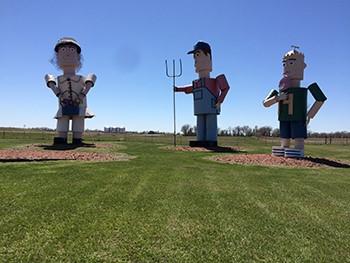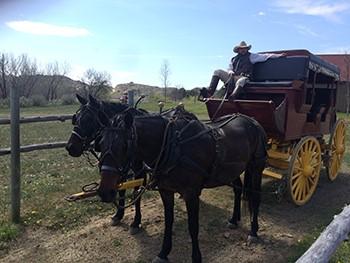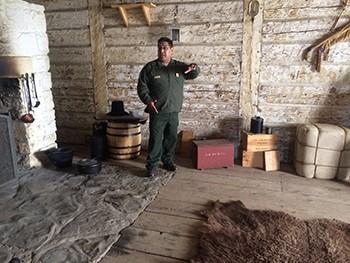Post Roundup FAM. Truly Legendary

I’ve heard a lot about her and so we can call her legendary. It was quite the sight to see the 38-foot-high, 50-foot-long, largest-Holstein-cow-on-earth named Salem Sue up close and personal. Dairymen, farmers and area businesses pooled resources to build the cow as a hallmark to the dairy and farming industry in the area. It was a fun first stop on a legendary FAM tour.
 Continuing with the unusual roadside art, we were guided along the Enchanted Highway. These giant metal sculptures were amazing and include “World’s Largest Tin Family,” “Teddy Rides Again,” “Pheasants on the Prairie,” “Grasshoppers in the Field,” “Geese in Flight” and “Deer Crossing.” The vision, artistic eye and dedication of Regent, North Dakota, artist Gary Greff is amazing. We learned that it takes four years for a sculpture to progress from idea and construction to installation along the highway. I highly recommend taking the short bypass south as you make your way west from Bismarck to Medora. You’ll leave enchanted!
Continuing with the unusual roadside art, we were guided along the Enchanted Highway. These giant metal sculptures were amazing and include “World’s Largest Tin Family,” “Teddy Rides Again,” “Pheasants on the Prairie,” “Grasshoppers in the Field,” “Geese in Flight” and “Deer Crossing.” The vision, artistic eye and dedication of Regent, North Dakota, artist Gary Greff is amazing. We learned that it takes four years for a sculpture to progress from idea and construction to installation along the highway. I highly recommend taking the short bypass south as you make your way west from Bismarck to Medora. You’ll leave enchanted!
On to Dickinson. We blew in in what felt like 100-mile-per-hour winds and stopped for the Dickinson State University rodeo at the brand-new fairgrounds. Our group was surprised with a shout out from the rodeo announcer. Many in our group of international tour operators had never experienced a rodeo, so it was perfect timing to be able to showcase western culture and explain the sport of rodeo. I felt for the cowboys and cowgirls battling that wind. Looked tough. As a dude from Wyoming, it was a first for me to see goat tying, so that was interesting and cool.
 After a quick tour of the Dakota Dinosaur Museum, where there are some amazing geo-stones and fully intact dinosaur fossils, we were on our way to Medora and the first glimpse of Theodore Roosevelt National Park at the Painted Canyon overview. Bison were conveniently hanging out here and so our international guests had a nice treat right away.
After a quick tour of the Dakota Dinosaur Museum, where there are some amazing geo-stones and fully intact dinosaur fossils, we were on our way to Medora and the first glimpse of Theodore Roosevelt National Park at the Painted Canyon overview. Bison were conveniently hanging out here and so our international guests had a nice treat right away.
Up early the next morning, we were treated to some bomb breakfast sandwiches in Medora and a beautiful blue sky. We stopped at a few overlooks along the South Unit loop road to take in the serenity of the park. Spring was in the air and the group was delighted to see several “little red dogs” as they call newborn bison – aka the national mammal. As we continued, we finally saw some of the park’s famous wild horses also with fresh spring foals. What an unsung national park. Worth it!
Next, we were off to Medora’s namesake residence, the Chateau de Mores State Historic Site. The house sits on a bluff overlooking Medora and provides a glimpse into a bygone time and the founding of the cow town in 1883 by French nobleman Marquis de Mores. Beginning in early June, the town plays host to a musical extravaganza, pitchfork fondue supper and opportunities for trail rides. Mountain biking and hiking are abundant. It is the perfect basecamp to explore Teddy’s park.
 We continued our experience in Medora with a thrilling stagecoach ride with Badlands Stagecoach & Conveyance Company and learned about the travels of past guests at Chateau de Mores. Back in the late 1800s, one would need to take a train from the East Coast to the Wild West town of Deadwood, Dakota Territory, and then travel some 36 hours non-stop on a stagecoach to get to Chateau de Mores for their hunting trip. Much easier to get to the Real America in 2017!
We continued our experience in Medora with a thrilling stagecoach ride with Badlands Stagecoach & Conveyance Company and learned about the travels of past guests at Chateau de Mores. Back in the late 1800s, one would need to take a train from the East Coast to the Wild West town of Deadwood, Dakota Territory, and then travel some 36 hours non-stop on a stagecoach to get to Chateau de Mores for their hunting trip. Much easier to get to the Real America in 2017!
After visiting the site of the Medora Musical, Pitchfork Fondue and the North Dakota Cowboy Hall of Fame, we made our way to Watford City and ended the day with delicious pizza and brews at the Stonehome Brewery. Interestingly, the head brew master named all his beer vats after pop stars (instead of boring numbers), which I thought was a funny touch.
 On to the Williston area where we saw Fort Union Trading Post National Historic Site. Very cool history to this area, especially if you’re interested in the 1800s fur trade on the Upper Missouri River. We were greeted in the reception room of the fort by National Park Service ranger and Arikara historian Loren Yellowbird, who gave us the rundown about how the fort was established and business conducted back in the day. We ended the morning at Fort Buford, where we stood in very same room where legendary Native American leader Sitting Bull surrendered in July 1881.
On to the Williston area where we saw Fort Union Trading Post National Historic Site. Very cool history to this area, especially if you’re interested in the 1800s fur trade on the Upper Missouri River. We were greeted in the reception room of the fort by National Park Service ranger and Arikara historian Loren Yellowbird, who gave us the rundown about how the fort was established and business conducted back in the day. We ended the morning at Fort Buford, where we stood in very same room where legendary Native American leader Sitting Bull surrendered in July 1881.
We moved on to New Town and the Earthlodge Village overlooking Lake Sakakawea. We took in the pageantry of Native American dancing and learned the history of the Mandan, Hidatsa and Arikara Nation and the tourism opportunities available to international guests. We ended our time here by taking in a breathtaking view of Lake Sakakawea and the site where William Clark waited to reunite with Meriwether Lewis on their famous exploration of the West.
Continuing to Minot, we walked through hanger after hanger of amazing aviation history and historic airplanes. The B-25 gunner “Betty’s Dream,” and many other historic war planes were incredibly still operational. Ending our time in Minot, we did a tour of the Scandinavian Heritage Park. The replica of the Stave Church from Gol, Norway, was very interesting.
North Dakota lives up to its legendary tagline. We walked in the footsteps of icons like Lewis & Clark, President Theodore Roosevelt, Lt. Col. George Custer and Sitting Bull. American history, western culture and warm hospitality is alive and well in modern North Dakota. I urge you to add North Dakota to your bucket list!
Mathias Jung is the CEO or Rocky Mountain International